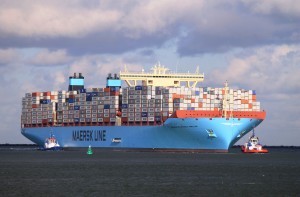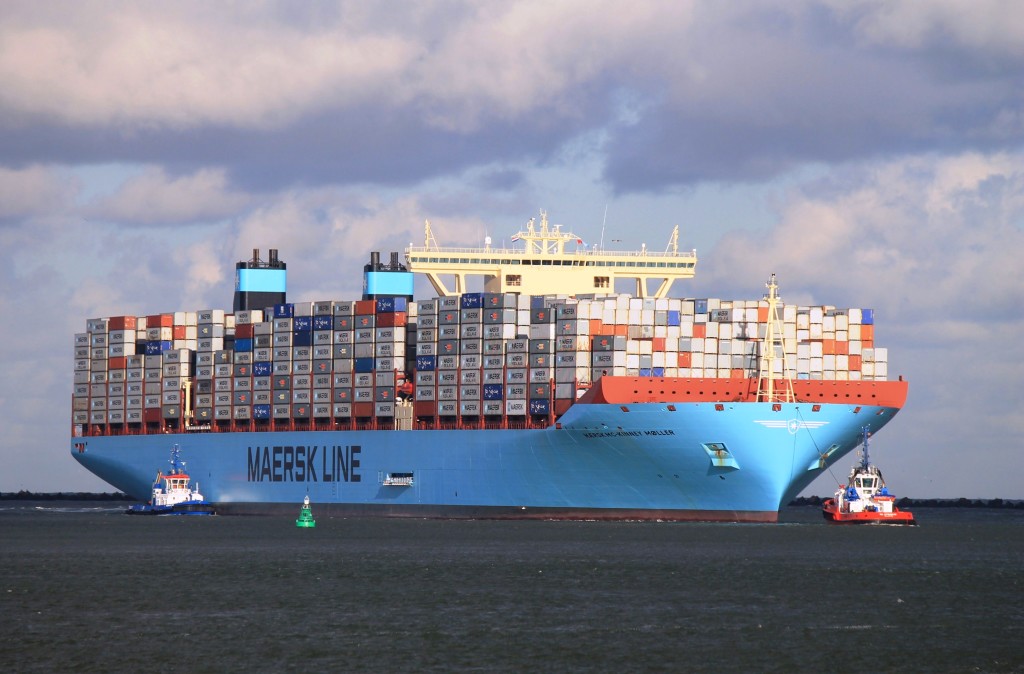
There are 56 container ships of 18,000 + TEU on order slated for delivery from April, 2017 till June, 2020. The mega boxships are intended predominantly to sail on the North Europe-Far East trade dominated by carrier alliances that have been freshly reshuffled.
The neck and neck battle for market share among carrier companies has seen two of these sea giants break world records over the past month with the delivery of 20,150 TEU MOL Triumph at the end of March followed by Madrid Maersk, a 20,568 TEU boxship delivered in early April, which took the title as the world’s largest containership in less than two weeks from MOL’s megaship.
MOL Triumph has already started operating in THE Alliance’s Asia-Europe trade in April, within FE2 service, and has called several ports on its maiden voyage. Madrid Maersk is yet to enter into service on the same trade under 2M alliance. The two container vessels form part of larger orders for six and eleven boxships yet to be delivered to the two shipping majors, MOL and Maersk Line, by 2018.
Container shipping companies rushed to join the ordering spree for these leviathans in 2015 lured by the economies of scale the ships of this size promised to bring, however, with the latest downturn of the market prompted by oversupply of tonnage, a question arises whether the 18,000+ TEU can deliver just that.
56 container ships of 18,000 + TEU to be delivered by 2020
“Whether any ship will deliver profits, purely depends on overall deployment of capacity on each route for all the liner companies on that trade. All container ships, including the 18,000+ TEUs ships must have quite a high utilisation rate of its capacity to return profits to its operator,” BIMCO’s Chief Analyst Peter Sand said. “Larger ships are more expensive to run, and the benefits from economies of scale can only be reaped with fuller ships sailing.”
The deployment of the said ships on the North Europe-Far East is likely to result in further cutting of weekly sailings on the route, according to Dutch consultancy Dynamar, from the current 17, unless a more than abundant growth of volumes is unleashed.
“Some ten years ago, in 2007, there were 32 weekly services on this route, maintained by 267 ships of 7,300 TEU average,” Dynamar said.
As explained by Sand, “the ‘overhaul’ of the NE-FE trade is in phase two (or three) now – and cascading of smaller ships onto secondary trades will continue. The pace of it will depend on the demand growth.”
The pending arrival of the colossal ships comes at a very vulnerable time for the container shipping industry with carriers joining forces within consolidation push aimed at securing higher profits.
Namely, 2016 was a wake-up call for the container shipping industry as freight rates plunged amid overcapacity and low trade growth inflicting losses across the board. According to the estimates of shipping consultant Drewry, industry operating losses in 2016 were close to USD 3.5bn.
But there seems to be a light at the end of the tunnel as 2017 promises to be a year of small profits for most container carriers.
“The short-term outlook for the container shipping lines looks good as the worst seems to have passed,” Drewry said.
“Taking a longer view, with fewer competitors thanks to the recent M&A wave and the ability to manipulate the supply and demand balance more in their favour through newbuild delays, there is a big upside there for the taking.”
Nevertheless, the expected recovery of the container shipping market may be too weak to enable the 18,000 TEU + ships to use their carrying capacity to the fullest. Some 1.7 million TEU of new capacity is due in 2017, according to Alphaliner’s data, the delivery of which remains a major roadblock to a swifter recovery of the market.
Whether there is still room for these mega ships in the market remains to be seen.
Copyright Ships & Ports Ltd. Permission to use quotations from this article is granted subject to appropriate credit given to www.shipsandports.com.ng as the source.

